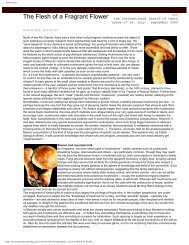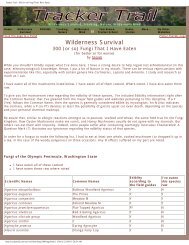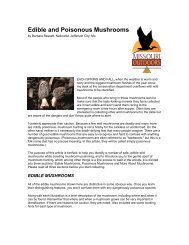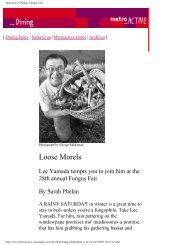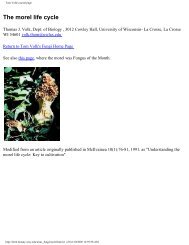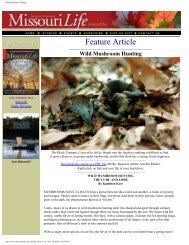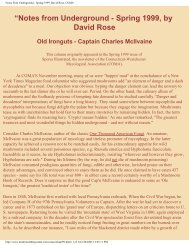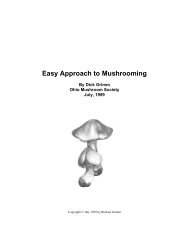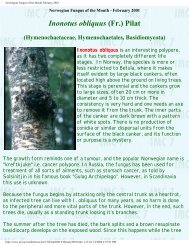Articles Template - The Mushroom Hunter
Articles Template - The Mushroom Hunter
Articles Template - The Mushroom Hunter
Create successful ePaper yourself
Turn your PDF publications into a flip-book with our unique Google optimized e-Paper software.
<strong>Articles</strong> <strong>Template</strong><br />
Home About CMS Contact CMS Meetings Officers NAMA Links<br />
❍ Information<br />
● Join CMS<br />
❍ Application 2006 ● Newsletter<br />
❍ About ● Forays<br />
❍ 2005 ● <strong>Mushroom</strong> Fair<br />
❍ Schedule ● <strong>Articles</strong><br />
❍ 2004 ● Recipes<br />
❍ Stalking<br />
❍ 2003<br />
❍ 2002<br />
Return to <strong>Articles</strong><br />
Index<br />
Dr.<br />
<strong>Mushroom</strong><br />
In His Own<br />
Words<br />
Fungi finally have their own PR man:<br />
Greg Mueller of the Field Museum<br />
As told to Cal Fussman<br />
Re-printed with<br />
permission.<br />
Discover Magazine, July<br />
2005, Vol. 26, No. 7.<br />
How can you tell if a mushroom is poisonous Well,<br />
there are a lot of old wives' tales out there.<br />
Boil them with a silver dollar. If the coin turns black,<br />
they're poisonous. This is one that can really get you<br />
into a lot of trouble.<br />
It's edible if it's growing on wood. Nope, there's a<br />
deadly species of Galerina that grows on wood.<br />
Watch the deer and squirrels and eat what they eat. Au<br />
contraire. <strong>The</strong>re are different digestive systems. A deer<br />
can eat poisonous amanitas that would kill a human.<br />
Unfortunately, there's only one rule that can be applied<br />
to the dinner table: You have to know exactly what<br />
kind of mushroom you've picked to know if it's edible.<br />
And if you don't Well, that's why, between April and<br />
October, my phone rings at three in the morning. A<br />
mycologist knows.<br />
When I was a kid growing up in Southern Illinois, I'd<br />
see mushrooms and think they were something to be<br />
kicked. I didn't know their purpose. Many people have<br />
no idea. When I tell grown men and women what I do,<br />
their eyes generally narrow as if asking a single<br />
question: Why would anybody spend his life studying<br />
mushrooms<br />
So I get to educate them. and usually by the end of the<br />
conversation, they understand why I'm so passionate<br />
about these organisms and other macrofungi. Hey, if<br />
you don't know about something, how can you be<br />
excited about it<br />
<strong>Mushroom</strong>s are among nature's great recyclers. <strong>The</strong>y<br />
break down dead wood and dead leaves. That may<br />
http://www.cmsweb.org/articles/drmushroom.htm (1 of 7)1/1/2006 6:53:56 AM
<strong>Articles</strong> <strong>Template</strong><br />
seem confusing on the surface. A mushroom may pop<br />
up in a week, a year — or maybe every few years. But<br />
you do see a lot of dead leaves and decomposing wood<br />
out there.<br />
When you think of a mushroom, you have to see it like<br />
the apple on an apple tree. It's the fruit body that<br />
produces the spores. Most of the mushroom is growing<br />
underground and forming what's called the mycelium.<br />
That's the part that interacts with the environment and<br />
decomposes things.<br />
Ever pull up the bark of a decomposing tree<br />
Sometimes you'll see this white stuff. That's the<br />
mycelium of some mushroom or another macrofungus<br />
at work. It's giving off enzymes that are breaking down<br />
the cellulose and the lignin. Without mushrooms and<br />
other fungi, we'd have miles and miles of logs. Without<br />
mushrooms, there'd be no space for anything to grow.<br />
If you're interested in conservation ecology, this is<br />
exactly where you ought to start. <strong>Mushroom</strong>s are not<br />
only critical components in recycling nutrients back<br />
into the soil for plants and animals to use; many form<br />
an obligate symbiosis with trees in the forest.<br />
Oak, spruce, pine, fir, eucalyptus — none of them can<br />
grow and survive without their appropriate fungi. <strong>The</strong><br />
roots of each tree and the mycelium combine to form a<br />
sheath around the roots. <strong>The</strong> fungus brings water and<br />
nutrients into the trees, and it feeds on the excess<br />
sugars produced by the trees. <strong>The</strong> system is so well<br />
balanced, we call it mutualism. <strong>The</strong> tree cannot get the<br />
necessary nutrients and water without the fungus, and<br />
the fungus cannot grow without its carbon source.<br />
People in forest management are now recognizing how<br />
critical this symbiosis is. In order to manage what's<br />
above the surface, they have to take into account what's<br />
going on beneath it.<br />
<strong>The</strong> most recent data have shown there is a flow of<br />
nutrients from one type of tree to different types of<br />
trees through these mycelial networks. Ideas are in a<br />
state of flux right now as we try to figure out exactly<br />
what's going on. But one thing is sure: Analyzing trees<br />
in an isolated way is the wrong way to go.<br />
<strong>The</strong>re's a timber tree out in the Pacific Northwest<br />
called the Douglas fir. It's one of the most essential<br />
trees in the area from an economic standpoint and one<br />
of the most important forest trees from an ecological<br />
standpoint. <strong>The</strong>re are most likely nearly 1,000 species<br />
of fungi that react with this tree. If you pull any one<br />
out, will you have problems Is there some kind of<br />
ecological redundancy If we lose half, will the<br />
remainder work fine Are different fungi playing<br />
different roles in the protection against stress Are<br />
they fail-safe systems We don't know. But from a<br />
conservation standpoint, these are critical questions.<br />
http://www.cmsweb.org/articles/drmushroom.htm (2 of 7)1/1/2006 6:53:56 AM
<strong>Articles</strong> <strong>Template</strong><br />
You can get detailed maps of the distribution of almost<br />
every bird and mammal and how they cluster together.<br />
Try requesting maps for fungi. <strong>The</strong> answer you'll get is<br />
"Ask me that in 15 years." I'm trying to understand<br />
patterns, distribution, and diversity. I'd be a very busy<br />
guy even if I wasn't fielding up to 10 calls a week from<br />
people wondering exactly what they put in their<br />
spaghetti sauce.<br />
Sometimes the calls come in the afternoon. A parent or<br />
a teacher will see a kid with a mushroom in his or her<br />
mouth and freak out. It's mostly adults who get into<br />
the really nasty stuff. But kids can. I've seen the deadly<br />
amanita — Amanita virosa — under swing sets in parks.<br />
If someone eats this amanita, the amatoxin will stop<br />
RNA synthesis. That means it will inhibit cell division.<br />
<strong>The</strong> toxin will go about destroying cells throughout the<br />
body, but because blood circulates through the liver<br />
and kidneys, that's where the toxins accumulate.<br />
Onset of symptoms is between 12 and 24 hours. you get<br />
severe gastrointestinal problems. there's vomiting,<br />
diarrhea, and severe cramping. This will go on for a<br />
couple of days if there's no treatment. But then it will<br />
subside. You think, "Oh, I'm getting better." <strong>The</strong>n two<br />
days later, bango! Worse pain. If there's no appropriate<br />
treatment, you're dead in a couple more days. Cause of<br />
death is usually liver failure. We don't have an antidote<br />
for the amatoxins. We give activated charcoal — this<br />
slurry stuff. It absorbs the toxins and then passes<br />
through the system. We can also give dialysis. If you<br />
filter the blood, you reduce the level of the toxin. Last<br />
resort is a liver transplant. Luckily, nobody's died on<br />
my watch — although there have been people who've<br />
gotten so sick they wished they had.<br />
In the last three years, we've gone high tech in order to<br />
do triage very quickly. We've created an online Hotmail<br />
account called Shrooms-911. Now when there's a call<br />
from a hospital to the poison center in Illinois,<br />
instructions are given for taking digital images and<br />
having them e-mailed in. Wherever in the world my<br />
colleagues and I are, we can log on to Shrooms-911 and<br />
give a quick ID. We can recognize the mushroom and<br />
say, "You've got to get this person treatment" or "This<br />
is fine. Tell Mom to relax."<br />
If I can't identify it immediately, I can go to the<br />
herbarium at the Field Museum and pull out<br />
specimens in our collection to determine a match. Our<br />
herbarium is an organized collection of plants and<br />
fungi. In it we have more than 150,000 specimens of<br />
fungi from around the world. <strong>The</strong> majority are<br />
mushrooms, but lichens and microfungi are also<br />
included.<br />
You know how people have plant collections when<br />
they're young <strong>The</strong>y take a plant, stick it in their book,<br />
and let it dry out. We don't do that with mushrooms.<br />
http://www.cmsweb.org/articles/drmushroom.htm (3 of 7)1/1/2006 6:53:56 AM
<strong>Articles</strong> <strong>Template</strong><br />
Flattened mushrooms aren't very interesting. We use<br />
food dehydrators — the same machinery used to make<br />
dried apples or bananas. <strong>The</strong>y blow air at low heat and<br />
dry the mushroom out. So we've got shriveled-up<br />
mushrooms. <strong>The</strong>y don't look as beautiful as they did<br />
when picked, but when I add to the the collection, I<br />
always take photographs and describe the color and<br />
size. If I need to identify a mushroom that's been sent<br />
in, I can search for a match by taking piece of dried<br />
mushroom in our herbarium, rehydrating it, and<br />
putting it under the microscope. All the features are<br />
there. We can also extract DNA. So these specimens<br />
have a lot of value.<br />
Of course, I need to know what I'm trying to match.<br />
That's why I always tell people: "When you collect<br />
mushrooms, save at least one in a brown paper bag in<br />
the refrigerator. If there is a problem after you've<br />
eaten, then we'll have a readily identifiable specimen."<br />
People eat these nice meals at 6 or 7 p.m. At 8,<br />
something feels wrong. Around 10 or 11, they're in the<br />
emergency room, and a state trooper is running a<br />
sample of the mushroom to my office. Maybe I get the<br />
mushroom at 1 or 2 in the morning and put it under<br />
the microscope. One time, the only remnants were in<br />
the casserole. So I was picking through the casserole<br />
looking for the mushrooms. It can be worse. If there's<br />
no other way . . . well, it's not too hard to guess what<br />
the last stop is.<br />
Back in the days of Caesar they had mushroom tasters.<br />
Now there's a job for you, huh If the tasters lived, then<br />
Caesar would eat the mushrooms.<br />
In the mid-1860s, an ex-Army captain named Charles<br />
McIlvaine decided that he would spend his retirement<br />
tasting mushrooms. He wanted to judge his body's<br />
reaction to the mushrooms he tasted, so he didn't try<br />
them within a day or two of each other. He kept<br />
voluminous notes. He ended up writing a book called<br />
One Thousand American Fungi. What he learned has<br />
stood the test of time — although if you follow his book<br />
to the letter you might get yourself into trouble. He was<br />
fortunate to have had an iron stomach, and he died of<br />
natural causes. He obviously knew better than to<br />
sample an amanita.<br />
Amanitas contain one of the deadliest poisons found in<br />
nature. <strong>The</strong> mushroom starts as an egg-shaped button<br />
that resembles a small puffball. This breaks open as the<br />
mushroom grows. Once it's developed an amanita will<br />
be gilled with parasol-shaped caps. <strong>The</strong>y come in<br />
white, yellow, red, and brown. But the gills are white.<br />
<strong>The</strong>y don't call Amanita virosa the destroying angel for<br />
nothing. One cap can kill a person.<br />
Galerina has the same deadly compound as Amanita<br />
virosa. It's a small brown mushroom that grows on<br />
wood. <strong>The</strong> problem with Galerina is that it's known to<br />
http://www.cmsweb.org/articles/drmushroom.htm (4 of 7)1/1/2006 6:53:56 AM
<strong>Articles</strong> <strong>Template</strong><br />
grow intermixed with honey mushrooms, which are<br />
good edibles. If you're willing to inspect closely, the<br />
two are easy to tell apart. If you cut the cap off, put it<br />
on a white piece of paper and let it sit overnight. <strong>The</strong><br />
honey mushrooms will reveal white spores, Galerina<br />
has brown spores.<br />
<strong>The</strong>n you've got false morels. Morels are some of the<br />
best edible mushrooms. <strong>The</strong>y look like honeycombs,<br />
and they're hollow inside. False morels resemble the<br />
shape of a brain. <strong>The</strong>y're solid inside. <strong>The</strong>y have<br />
monomethylhydrazine inside them, which is basically<br />
rocket fuel. <strong>The</strong>re have been fatalities, but others have<br />
eaten them and survived. Studies indicate that the<br />
toxins are cumulative. So you can eat them a few times<br />
without problems, and you have no idea you're eating<br />
your last supper.<br />
<strong>The</strong> two most commonly eaten mushrooms that you<br />
don't want to eat around Chicago are the jack-o'-<br />
lantern and the green-spored lepiota. <strong>The</strong> jack-o'-<br />
lantern is pumpkin colored and grows in clusters on<br />
wood. It has gills coming down the stem. It actually<br />
glows, but the green glow is so faint in the light that<br />
you can't see it. People think they look like<br />
chanterelles, which are delicious edibles and also have<br />
pleasant smell. But if you see the two together, you'll<br />
never confuse them. Chanterelles have flat-edged<br />
interconnecting ridges or wrinkles instead of knifelike<br />
gills.<br />
<strong>The</strong> green-spored lepiota grows in yards or grassy<br />
areas. It's a big mushroom that grows in a fairy ring.<br />
It's white and looks very innocent and pure. As the<br />
mushroom matures, the gills turn green. A couple of<br />
lepiotas are great edibles. but the green-spored lepiota<br />
will give you major diarrhea and vomiting. You'll have<br />
to check into hospital for dehydration. Depending on<br />
your personality, you'll either be embarrassed or you'll<br />
have a great story.<br />
When you travel around the world, you find there are<br />
mycophiles or mycophobes. People tend to either love<br />
mushrooms or be fearful of them. Folks from the U.K.<br />
for instance, are generally not into eating mushrooms.<br />
But collecting and preparing mushrooms is a big<br />
pastime in France, Russia, and China.<br />
I'm not overly adventurous when I'm eating<br />
mushrooms, but there a are a few that I love. <strong>The</strong> black<br />
trumpet — it's also called the horn of plenty — is one of<br />
my favorites. It's hard to see because it's only a couple<br />
of inches tall. You'll have to get down on your hands<br />
and knees to find one. It looks like a black hearld's<br />
trumpet and has this wonderful nutty flavor. I don't<br />
like to hide the flavor, so I just sauté them with a little<br />
olive oil.<br />
Puffballs can grow as big as volleyballs and are usually<br />
between a forest and a grassy area. You find them on<br />
http://www.cmsweb.org/articles/drmushroom.htm (5 of 7)1/1/2006 6:53:56 AM
<strong>Articles</strong> <strong>Template</strong><br />
bike trails. You can get multiple meals out of one. You<br />
can cut it up and put it in pasta. Or if you want to have<br />
a little fun, you can make a puffball pizza. Slice the<br />
mushroom into a nice crust, put on cheese and tomato<br />
sauce, then toss it in the oven and bake.<br />
<strong>The</strong> golden chanterelle has a beautiful orange color. It's<br />
usually found in oaks, but it can be in pine woods also.<br />
I get a a lovely apricot smell from the chanterelle. It<br />
goes nicely with light sauces.<br />
Boletes are soft and squishy with a nice texture that<br />
will stand up to the sauce in pasta. <strong>The</strong>y're found either<br />
in oaks or pines — often in people's yards. We had a<br />
case where a guy got sick after eating them, and the<br />
emergency room called. It took us a while to figure out<br />
why. This is a good, edible mushroom. Finally, we<br />
tracked the problem to its source and discovered that<br />
his neighbor had put an herbicide on the yard the week<br />
before. <strong>The</strong> mushroom had absorbed the herbicide,<br />
and the guy had herbicide poisoning. So I like to throw<br />
in my "know thy neighbor's lawn" caveat.<br />
Oh, and don't let me forget morels. <strong>The</strong>y come in<br />
springtime — in May around the Chicago area. Some<br />
say you can find them around dead elms. Morel<br />
hunters have their secrets. I'm not a good morel<br />
hunter, but I have some friends who take care of me. I<br />
like them in omlets. Sometimes we chop them up and<br />
put them in a roux with flour and milk and then pour it<br />
over melba toast. Ohhhhhhhh, so fine.<br />
I'm telling you, what this world needs is a little<br />
<strong>Mushroom</strong> Public Relations 101.<br />
We're trying to make the information more accessible.<br />
We have a virtual herbarium the Field Museum<br />
developed along with the Morton Arboretum and the<br />
Chicago Botanic Garden. You can find data for about<br />
90,000 plant specimens. We started with just plants of<br />
the Chicago area — www.vplants.org — and we're<br />
expanding to include an online field guide of<br />
mushrooms. <strong>The</strong>re will be a species page for all the<br />
mushrooms in the region where you can find an image<br />
and a short description. <strong>The</strong>re'll be a distribution map,<br />
and you'll be able to read about the ecology. We're<br />
trying figure out ways to unlock our data through the<br />
Web.<br />
Once you get started with mushrooms, you'd better be<br />
careful. You can get hooked pretty easily. Look what<br />
happened to me. I start out an ordinary kid in<br />
Belleville, Illinois, kicking mushrooms and growing up<br />
to play baritone horn in the high school marching<br />
band. Who would've known<br />
I meet this beautiful girl named Betty strolling across<br />
campus at Southern Illinois University in Carbondale.<br />
We get a job watering orchids and other plants at a<br />
greenhouse, and she introduces me to a mycologist.<br />
http://www.cmsweb.org/articles/drmushroom.htm (6 of 7)1/1/2006 6:53:56 AM
<strong>Articles</strong> <strong>Template</strong><br />
Double bingo! I get the girl and a course on fungi.<br />
I earn my undergraduate degree at Southern Illinois<br />
and a master's in mushrooms too. <strong>The</strong>n Betty and I<br />
head to the University of Tennessee for my doctorate.<br />
Next thing you know, we're hunting for mushrooms in<br />
Sweden while I work on my postdoctorate. And soon<br />
we're both at the Field, working an office apart. She's<br />
managing the scanning electron microscope facility<br />
that allows me to look at spores big time in 3-D. <strong>The</strong>n<br />
one day we're scavenging in a forest in Costa Rica, less<br />
than a football field apart, when I shout for her in<br />
shock. It's amazing that I can even get her name off my<br />
lips. She hurries over, and there it is: Macrocybe titans,<br />
the largest mushrooms in the world, more than three<br />
feet wide and in perfect condition. Nothing comes near<br />
this mushroom — neither bird nor insect — because of<br />
its cyanide odor. <strong>The</strong> two of us share a unique moment<br />
staring at this wonder of nature. And that's what love<br />
is. So be careful once you get started. You could end up<br />
like me, owning a few mushroom ties.<br />
Copyright © 2005, Colorado Mycological Society.<br />
All Rights Reserved.<br />
Last update: 07-Dec-2005<br />
Contact the Webmaster<br />
Home | Join CMS | Newsletter | Forays | Fair | <strong>Articles</strong> | Recipes | About CMS | Contact CMS | Meetings | Officers | NAMA | Links<br />
http://www.cmsweb.org/articles/drmushroom.htm (7 of 7)1/1/2006 6:53:56 AM



